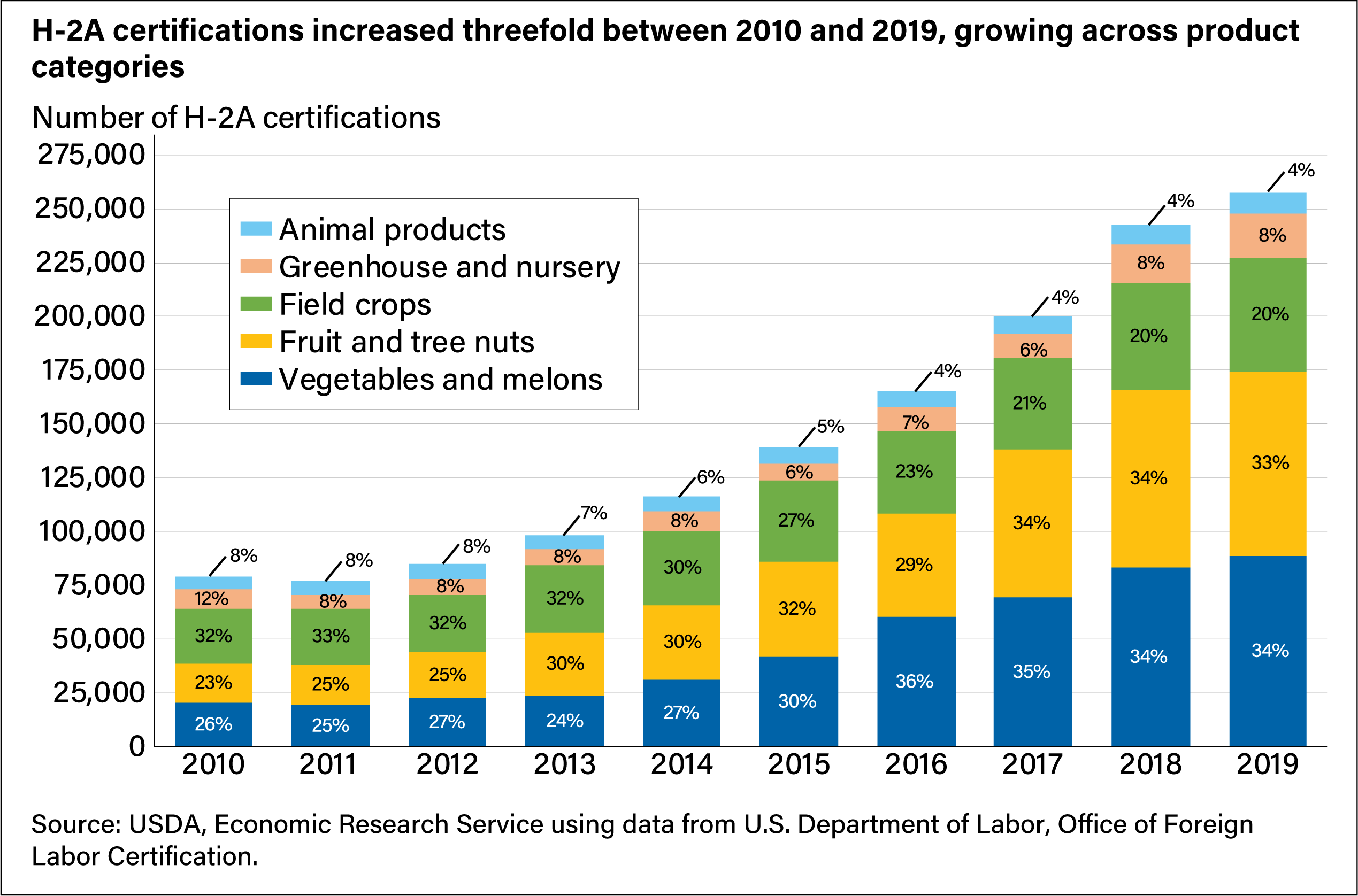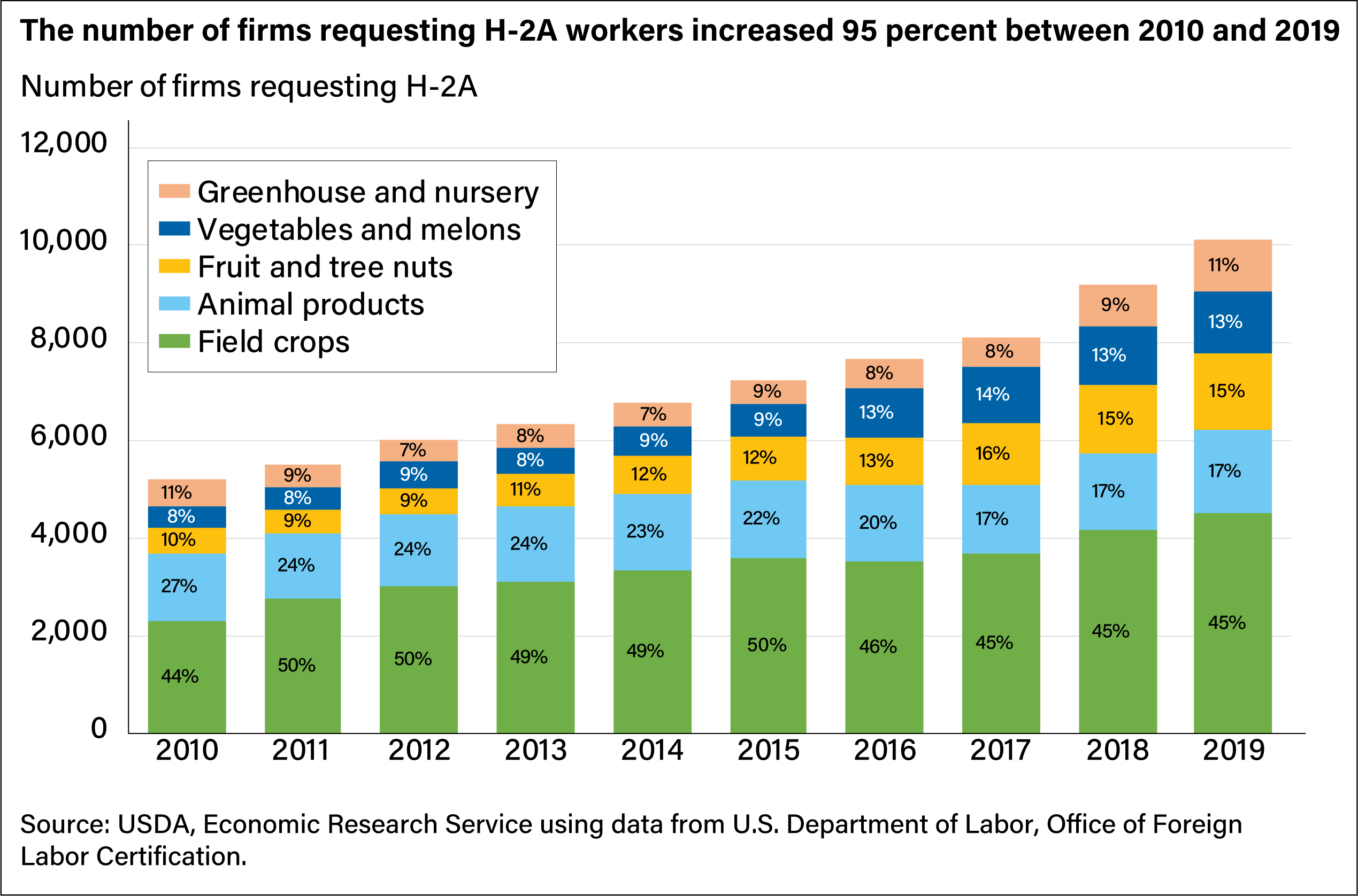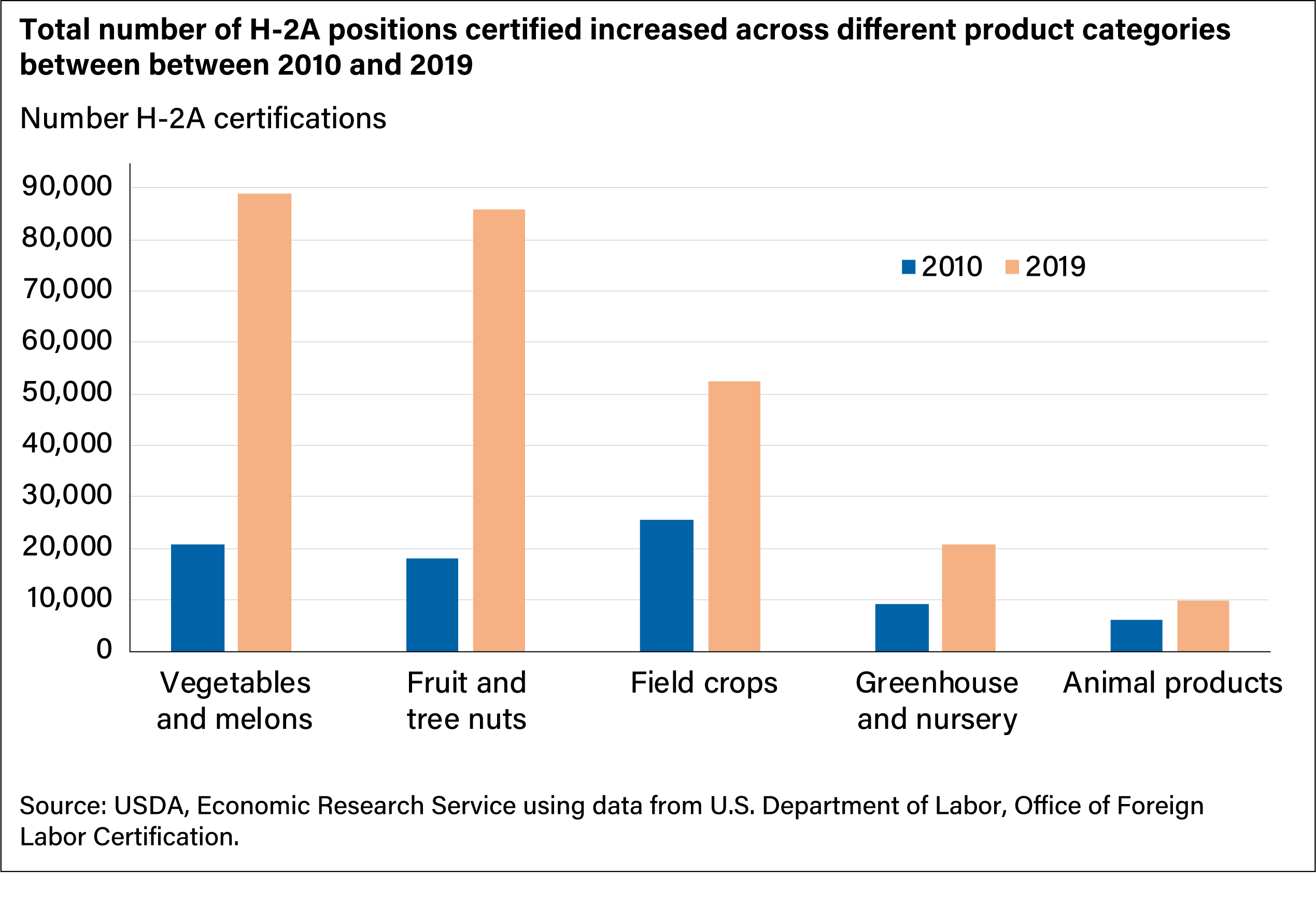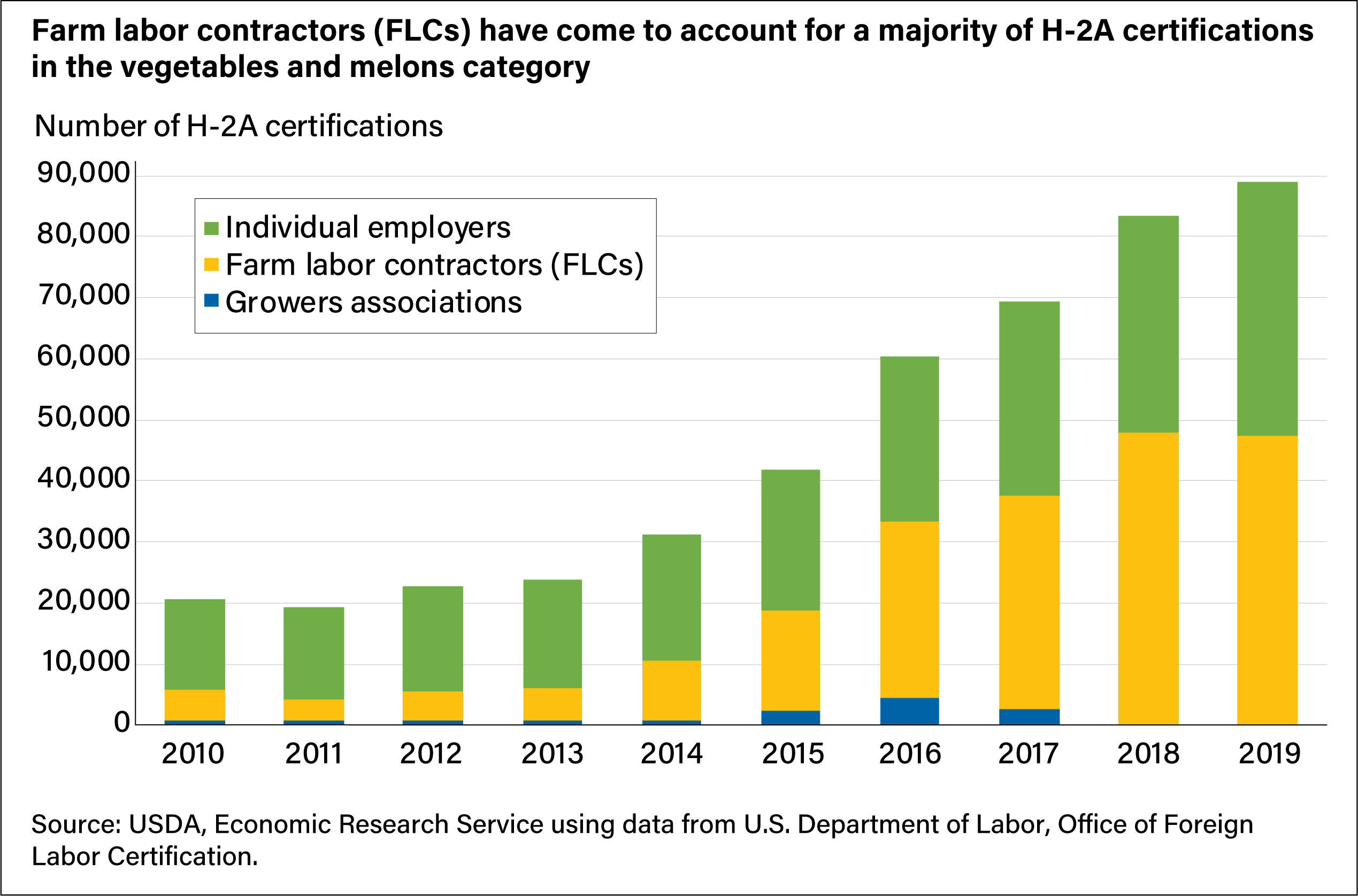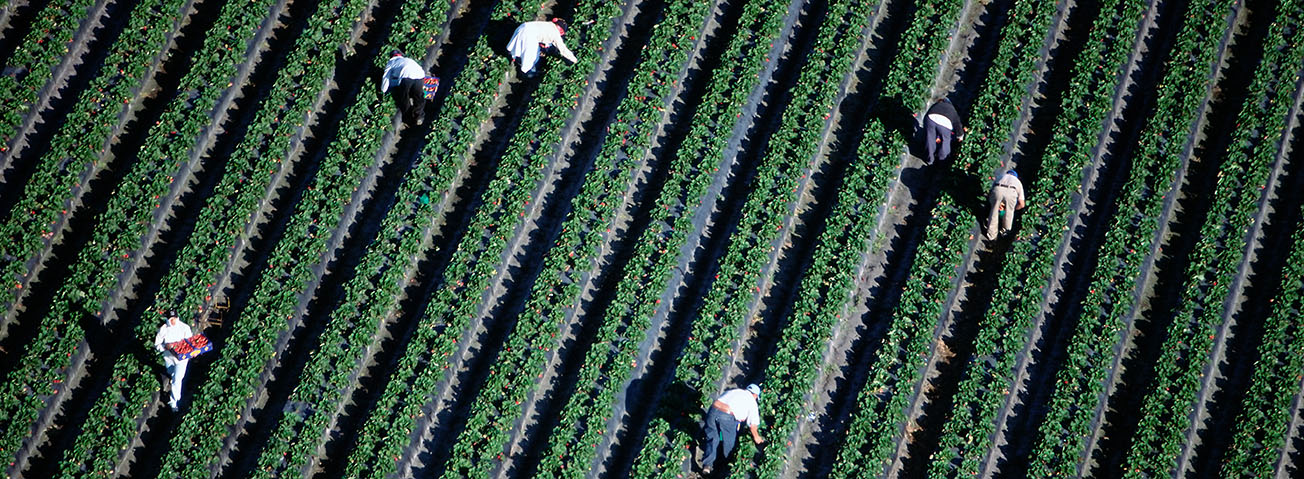
Use of H-2A Guest Farm Worker Program More Than Triples in Past Decade
- by Skyler Simnitt and Marcelo Castillo
- 9/7/2021
The H-2A Temporary Agricultural Workers Program allows agricultural employers in the United States to bring in foreign farmworkers to fill seasonal labor contracts lasting less than a year. Between 2010 and 2019, H-2A positions certified by the U.S. Department of Labor (DOL) increased more than 220 percent. All agricultural product categories experienced significant growth in H-2A employment, but the increase was most pronounced in product categories with high labor requirements and seasonal employment, such as fruit and tree nuts and vegetables and melons.
Some researchers and policymakers view this growth as evidence of a tightening of domestic farm labor markets. A decline in labor availability is especially challenging for producers of labor-intensive crops, such as fruits and vegetables requiring harvesting by hand; seed corn requiring detasseling; tobacco requiring curing; crawfish requiring shelling; or nurseries requiring pruning and repotting.
The number of firms requesting H-2A workers increased 95 percent from 2010 to 2019, from about 5,200 to 10,100 firms. A growing share of H-2A certifications is going to farm labor contractors (FLCs), possibly because contractors are finding it more difficult to recruit domestically, prompting them to turn their recruitment efforts abroad. In addition, individual agribusinesses may be finding it difficult to hire locally and thus, more often, turn to FLCs to navigate the H-2A application and recruitment process rather than doing it themselves.
Moreover, employing H-2A workers incurs additional costs that make it more expensive than hiring domestic workers. These costs include visa fees, housing, and travel, which many small producers may find prohibitive for short-term contracts. An FLC, on the other hand, can effectively share the cost of application fees, travel, and housing among multiple producers—making the hiring of H-2A workers through FLCs more feasible.
In 2019, DOL certified 258,000 individual H-2A positions, compared with 79,000 in 2010. While program growth over the last decade is well-documented, the nuances of this growth—particularly how it varies by product category and employer type—are less understood. To determine how H-2A use varies, USDA, Economic Research Service (ERS) researchers analyzed H-2A employment certification data spanning 2010 to 2019.
Employers wishing to hire H-2A workers submit an application to the Department of Labor, which compiles the information into case disclosure files. These files contain a wealth of information, including the number of positions certified and the crops for which the workers are needed. For the application years 2013-2019, the files include data on the type of employing firm. Since the latest round of H-2A growth started in 2010, ERS researchers extrapolated this information to application years 2010-2012 for repeat employers.
Number of Firms Using H-2A More Than Doubled Between 2010 and 2019
ERS researchers examined employer information in the disclosure files to identify the number of unique firms using H-2A guest workers across years, product categories, and employer types. H-2A employers generally fall into three categories:
- Individual employers: agribusinesses that directly employ H-2A workers and use their labor in-house;
- Growers associations: groups that typically consist of multiple farms and are frequently nonprofits that promote the professional interests of their member farms;
- Farm labor contractors, or FLCs: essentially farm labor brokerage firms that lease their workers’ services to farms.
While searching for unique employer names (adjusted for misspellings) was an effective method of determining the number of unique employers among individual firms, researchers used a different approach in the case of growers associations and FLCs. A single growers association or FLC may provide H-2A workers to multiple end users at different locations. For growers associations, ERS researchers counted the number of individual farms filing jointly with the association to employ H-2A workers. The DOL data do not record the number of farms serviced by FLCs, so researchers used the number of unique worksites to approximate the number of firms using H-2A through FLCs.
All product categories experienced growth in the number of firms making a request, with fruit and tree nuts and vegetables and melon producers increasing the most—200 percent and 191 percent, respectively. In absolute terms, the number of firms requesting H-2A labor increased the most in the field crops category, from 2,300 firms in 2010 to 4,500 firms in 2019, a 95-percent jump.
By firm type, the number of FLC worksites requesting H-2A workers increased the most—around 780 percent between 2010 and 2019. By comparison, the number of individual employers requesting H-2A workers increased by around 121 percent. And the number of farms requesting H-2A workers jointly with a growers associations peaked mid-decade, then dropped by roughly 40 percent.
FLCs are major users of H-2A labor in the field crops, vegetables and melons, and fruit and tree nuts categories. Between 2010 and 2019, the share of FLC worksites requesting field crops ranged from 16 to 43 percent of all FLC worksites participating in the program. Over the same period, the share of worksites using H-2A workers through FLCs for vegetables and melons ranged from 15 and 41 percent. And the share of FLC worksites requesting H-2A workers for use in the fruit and tree nuts category ranged from 24 to 36 percent.
Producers of Vegetables and Melons and Fruit and Tree Nuts Are the Dominant Users of H-2A
The number of H-2A positions certified in the vegetables and melons category grew from about 20,600 in 2010 to 88,900 in 2019—an increase of 330 percent. At the same time, the number of certifications in the fruit and tree nuts category increased nearly 400 percent, from about 18,100 to 85,800. Certifications increased 127 percent in the greenhouse and nursery category, 106 percent in the field crops category, and 63 percent in the animal products category.
Individual employers and FLCs are the dominant H-2A employer type in the vegetables and melons category, together accounting for virtually all the positions certified in 2019. FLCs accounted for 53 percent of positions certified in vegetables and melons that year. Between 2010 and 2019, the number of certifications for FLCs in this product category increased 870 percent.
Individual employers and FLCs are also the dominant H-2A employers in fruit and tree nuts. The number of certifications for FLCs in that product category increased over 1,200 percent over the decade—from about 2,900 to 38,900, accounting for 45 percent of all certifications in the category in 2019. By comparison, certifications by growers associations in fruit and tree nuts never accounted for more than 11 percent of all certifications in that category between 2010 and 2019.
FLCs accounted for a growing share of the positions certified in the field crops category, increasing from 7 percent in 2010 to 26 percent in 2019. Growers associations also accounted for a significant share of certifications in field crops throughout the decade, fluctuating between 37 and 18 percent, possibly because the North Carolina Growers Association is the largest single employer of H-2A workers in the country.
This article is drawn from:
- Castillo, M., Simnitt, S., Astill, G. & Minor, T. (2021). Examining the Growth in Seasonal Agricultural H-2A Labor. U.S. Department of Agriculture, Economic Research Service. EIB-226.
You may also like:
- Zahniser, S., Taylor, J.E., Hertz, T. & Charlton, D. (2018). Farm Labor Markets in the United States and Mexico Pose Challenges for U.S. Agriculture. U.S. Department of Agriculture, Economic Research Service. EIB-201.
- Astill, G., Perez, A. & Thornsbury, S. (2020). Developing Automation and Mechanization for Specialty Crops: A Review of U.S. Department of Agriculture Programs. U.S. Department of Agriculture, Economic Research Service. AP-082.
- Zahniser, S., Hertz, T., Rimmer, M.T. & Dixon, P.B. (2012). The Potential Impact of Changes in Immigration Policy on U.S. Agriculture and the Market for Hired Farm Labor: A Simulation Analysis. U.S. Department of Agriculture, Economic Research Service. ERR-135.


